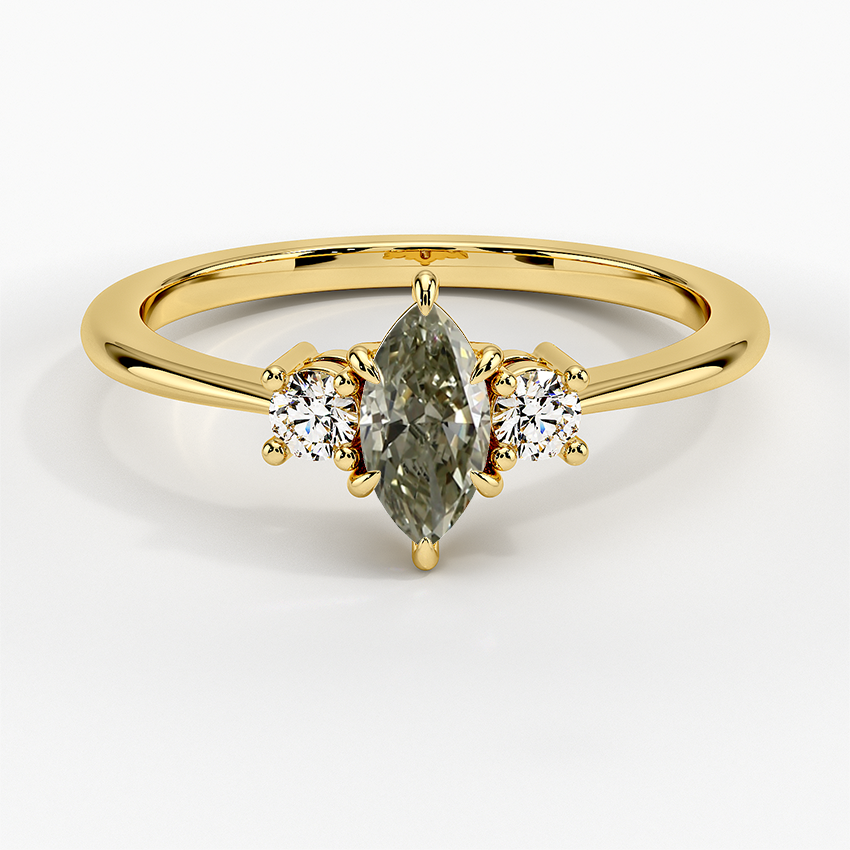What to Watch: Dishwater Diamonds — The Engagement Ring Trend for Brown and Gray Stones

The engagement ring rush is on, and with that is a new and unexpected trend in diamond choices.
With 2022 expected to bring some 2.47 million weddings, according to industry research group The Wedding Report — which would mark a four-decade high — many brides-to-be feel hard-pressed to find an engagement ring that seems unique and personal.
More from WWD
And so enters the latest trend in engagement rings: dishwater diamonds. Brown, gray, champagne-tone or salt-and-pepper colored stones — hues native to one’s kitchen sink during meal cleanup — are seeing growing traction.
The stones are becoming popular for a handful of reasons. They are more accessibly priced, meaning couples can get a higher carat weight that suits their budget. They are unique and often possess flaws that can feel more personal than perfect stones and, in some cases, shoppers say the earth tones make them feel closer to diamonds’ nature origin story.
Large-scale jewelers that specialize in bridal jewelry like Brilliant Earth and Blue Nile are seeing growing interest in dishwater diamonds, which they say are connected to a larger pursuit of individuality in engagement rings.
While simple diamond solitaire rings with a white diamond as the focal point will always remain the category’s bread and butter, “there are more acceptable options now. Customers are picking what suits their needs and what they love,” said Brilliant Earth cofounder and chief executive officer Beth Gerstein. The trend, she added, has gained steady steam since about the midway point of the pandemic.
Brown and gray diamonds are actually part of the fancy color category, much like a pink or yellow stone. Salt and pepper diamonds, however, are named for the mineral and soil deposits caught within the stones, which are also known as inclusions. While heavily included stones were once discarded by the jewelry industry and used in industrial applications, like drill bits, they are also now falling into favor — particularly with indie jewelers like Prounis, Eva Fehren and Polly Wales.
“This is definitely part of a broader trend in diamonds and diamond jewelry to be more individualistic and innovative. Jewelry is such a nice and individual expression of yourself, unlike other products. There is also a greater sense of naturality, so the fact that diamonds come from the earth and were made over billions of years, these inclusions mean no two diamonds are alike and they can carry even greater interest. People who are buying diamonds with inclusions or imperfections generally appreciate that what comes from the earth isn’t born perfect,” said Natural Diamond Council CEO David Kellie.
The NDC, as it’s known, operates an annual program for emerging designers that is spearheaded by Lorraine Schwartz. This year Schwartz mentored young designers to work with brown, taupe and included diamonds and they ultimately became a focus for designer Marvin Linares’ collection for the initiative.

Courtesy/Brilliant Earth
“You can get a fairly large stone or unique cut that you would not typically get in the same size and cut in very white stone,” said Blue Nile’s chief merchandising officer Katie Zimmerman.
Both Brilliant Earth and Blue Nile operate website features that allow shoppers to design a custom engagement ring. Both companies have seen a greater demand for dishwater-tone diamonds and are now actively working to source more stones in that category.
“That [fancy colored stone] customer was much more interested in a vibrant yellow, blue or pink diamond in the past but now it’s a much broader range of color… we are adding more and more to our selection, we see a lot of interest in them,” said Gerstein.
Zimmerman said one recent custom engagement ring that comes to mind was “a heart-shaped diamond that we sold, it was a fancy brown heart that was put into an engagement ring setting with a vintage-y feel. It was four carats and VS1 clarity in a darker brown color that sold for about $30,000. In a white diamond that stone would have probably been $100,000 to $150,000. So at Blue Nile we are actively sourcing to add suppliers [of these stones]. A lot of vendors have core competencies and many focus on true white diamonds, so [it is a challenge].”
The dishwater diamonds are also ushering in a larger significant change in engagement ring choices: a move toward yellow and rose gold settings. While platinum and white gold settings have been the de facto choices for brides-to-be for the major part of the last two decades, some are opting for warmer metal tones now to complement unique colored diamond choices.
“You can use different metals to enhance the color of the stone, so you will see more of a yellow gold or rose because of the contrast,” Zimmerman said.
“With more champagne and brown diamonds, a warm hue sets it off nicely — it looks nice with that tone of yellow or rose gold,” added Gerstein. “[Shoppers] are demonstrating a lot of popularity there; we definitely see an increase.”
Sign up for WWD's Newsletter. For the latest news, follow us on Twitter, Facebook, and Instagram.

